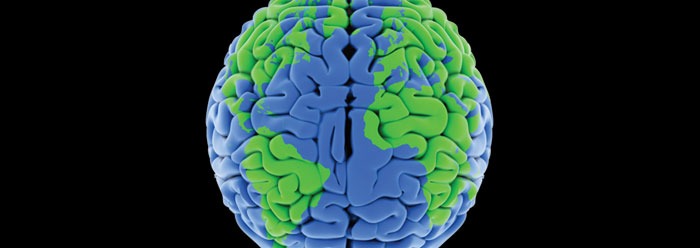Christians can be confident in claiming that the power of the Lord Jesus Christ is the best explanation for complex design found in nature, "for the invisible things of him from the creation of the world are clearly seen, being understood by the things that are made" (Romans 1:20). They also have an excellent scientific basis to know that creatures were made fully formed with innate abilities to diversify, multiply, fill, and fit their environments with great varieties of their kind.
Evolutionists claim that creatures only appear to be designed since their existence is best explained by the interaction of genetic mutations and natural selection. Natural selection includes the capability for creatures to generate various heritable traits with varying degrees of impact on their survival. The key question to evolutionists is: What originally initiated this ability to generate traits? They claim natural selection produced it by working on nature's emergent properties (spontaneously created complexity).1 This explanation is very weak--it is circular and invokes mystical environmental properties.
Evolutionists rely on ascribing an intention-to-act to the environment. They believe that for every trait in a creature, there is a corresponding environmental variable that caused it--such as polar bears' white fur and their arctic surroundings. The power behind variability is environmental, residing outside the creature.
This reveals why evolution advocates believe it is totally rational to explain that life's complexity results from the ever-upward pressure of natural selection's ability to see and save traits, though it, itself, is undirected and absolutely blind to any goal.
The Evolutionist's Dilemma
Evolutionists must use words like "undirected" and "blind" to reinforce that natural selection, not God, creates nature's design. But an unavoidable side effect is that those same words hinder people from accepting evolution. They resist believing that any process that cannot "see" needs, is "blind" to natural forces, has "undirected" plans or goals, and relies heavily on chance, can create complex design.
This dilemma divides evolutionists. For one faction, keeping naturalism pure from any hint of divine action is paramount. They do not flinch when asserting the almost exclusive role of blind chance. The other group's top goal is getting everybody to believe in evolution. They deftly downplay chance and push the concept that natural selection constructs methodically--in law-like fashion.1 Human evolution is now touted as being "inevitable."2 University of Chicago evolutionary biologist Jerry Coyne seems aware that people recoil from the suggestion that design results from chance. Note his forceful retort to Senator Sam Brownback:
Brownback also presents the familiar creationist misrepresentation of evolution as a chance process, claiming that "man...is merely the chance product of random mutations." He doesn't seem to know that while mutations occur by chance, natural selection, which builds complex bodies by saving the most adaptive mutations, emphatically does not. Like all species, man is a product of both chance and lawfulness.3
Coyne's assertion sounds formidable but is illegitimate. He attributes powers far beyond reality to environmental selection. He needs natural selection to behave lawfully, but it actually operates by chance, cannot see needs, and is too weak to halt the cumulative destructive effect of evolution's own fuel--mutations.
Environmental Processes Are Random
Unpredictable is the opposite of law-like and is a far more accurate description of earth's environments. Any trait suitable, or advantageous, for one environment may be unsuitable the next year. This uncertainty is why Harvard's greatest evolutionist, Ernst Mayr, said, "In fact, nothing is predetermined. Furthermore, the objective of selection may change from one generation to the next, as environmental circumstances vary."4
Extinction is another phenomenon demonstrating how powers attributed to natural selection are fabricated. Evolution by natural selection means that groups of creatures change over time by a specific process that demands that gradual development and gradual extinction go hand in hand. Most extinction should result from the slow, steady, relative decrease in survival due to the inability to compete with offspring or rivals; but is this true?
Extinction is historically how species respond to unpredictable and drastic environmental changes--not to "bad" genes. No evidence shows that extinct classes of creatures were less fit to survive normal environmental hazards than kinds alive today. Substantial worldwide environmental fluctuations, well-documented geologically, are known to cause massive extinctions. These are augmented by intermediate environmental instabilities, like the Ice Age. Thus, extinction largely results from being in the wrong place at the wrong time. As Mayr said, "Chance may be particularly important in the haphazard survival during periods of mass extinction."5
Environmental changes and mutations are chance-driven occurrences that would not be expected to tend toward biological improvements. Prominent evolutionary paleontologist David Raup candidly observed of the fossil record: "It is not always clear, in fact it's rarely clear, that the descendants were actually better adapted than their predecessors. In other words, biological improvement is hard to find."6 DNA studies reveal no consistent evolutionary trend toward increased genomic complexity.7 Even plant offspring cloned from one parent and subject to the same starting soil conditions and environmental pressures have differing numbers of flowers and seeds.8
Other than wishful thinking, there has been no uncontested discovery of any creative, dynamic, emergent property or lawfulness imbued in environments. Environmental selection is not a non-random deterministic force; rather, a lot of chance events are observed. Nature tolerates many inferior horses without eliminating them; some seeds with superior genetics land on rocks while inferior ones land on good soil; environmental changes cause arbitrary extinctions; and accidents happen to even the best animals.
Environmental Processes Are Blind
Darwin idealized the all-seeing, god-like attribute associated with natural selection:
It may be said that natural selection is daily and hourly scrutinising, throughout the world, every variation, even the slightest; rejecting that which is bad, preserving and adding up all that is good; silently and insensibly working, whenever and wherever opportunity offers.9
This is not true. Environments do not "see" any individual gene. Even when environmental factors influence the genome, these interactions are managed by innate features in DNA. Natural selection cannot unequivocally identify which trait was the one "selected for" for an animal in any environment--but natural selection is purported to explain the origin of an animal's design by recounting the history of its traits. Thus, evolutionists increasingly claim that changes even down to the molecular level result from neutral evolution that proceeds untouched by natural selection.10 Geneticists document that environments are powerless to eliminate most mutations. This buildup results in a total human genome degeneration of 1 to 2 percent per generation.11
Learning a Short Example
Is it reasonable to say that research has shown that, in the wild, natural selection of traits in any direction is so uncommon that it may not exist?
Yes. The American Naturalist published the largest analysis of the degree to which selection of changes of specific physical traits in an animal group affects their fitness--as measured by survival, mating success, and offspring. It tabulated 63 prior field studies covering 62 species and over 2,500 estimates of selection. Significance was obtained using statistical analysis and not opinions. The highest median correlation of trait selection to fitness was a low 16 percent. This means 84 percent of changes were not explained by selection. Directional and stabilizing selection were no more likely to happen than non-directional and disruptive selection. In studies with species sample sizes greater than 1,000, the correlation of selection to survival was essentially negligible.12
Pulling It All Together
When constructing arguments for design, it is important to know why the only other explanation for intelligent design--natural selection--does not work. Research shows that environmental changes are just as random as mutations. But limits are necessary to the amount of luck allowed into science--otherwise, it degenerates into magic. Claims of unquantifiable emergent properties or lawfulness are equally mystical. Nevertheless, evolutionists claim reproductive abilities were not designed, but emerged by natural selection's powers to blindly see traits and lawfully save them with no final purpose to build complexity.
Christians must categorically push back the invalid claim that environments select organisms or even traits. This fallacy is essential to perpetuating evolutionary theory. No natural explanation exists for how creatures originally reproduced varieties of traits. It is not survival of the fittest, it is really survival of the "fitted." Creatures came designed with innate abilities to diversify, multiply, and fill environments.
References
- For a thorough discussion, see Dennett, D. 1995. Darwin's Dangerous Idea. New York: Touchstone, 229-237.
- Is Human Evolution Inevitable? Southern Methodist University press release, January 29, 2010, regarding lecture by Cambridge Professor Simon C. Morris titled "Darwin's Compass: Why the Evolution of Humans is Inevitable."
- Coyne, J. 2007. Don't Know Much Biology. Edge. 212, June 6.
- Mayr, E. Darwin's Influence on Modern Thought. Scientific American. July 2000, 81.
- Mayr, E. 2001. What Evolution Is. New York: Basic Books, 281.
- Raup, D. M. 1979. Conflicts Between Darwin and Paleontology. Bulletin, Field Museum of Natural History. 50 (1): 23.
- Koonin, E. V. 2009. Darwinian evolution in the light of genomics. Nucleic Acids Research. 37 (4): 1011.
- Millstein, R. L. Is the Evolutionary Process Deterministic or Indeterministic? An argument for Agnosticism. Presented at the Seventeenth Biennial Meeting of the Philosophy of Science Association, Vancouver, Canada, November 3, 2000.
- Darwin, C. 1859. On the origin of species by means of natural selection, or the preservation of favoured races in the struggle for life. 1st edition, 1st issue. London: John Murray, 84.
- Clements, A. et al. 2009. The reducible complexity of a mitochondrial molecular machine. Proceedings of the National Academy of Sciences. 106 (37): 15791.
- Crow, J. F. 1997. The high spontaneous mutation rate: is it a health risk? Proceedings of the National Academy of Sciences. 94 (16): 8380.
- Kingsolver, J. 2001. The Strength of Phenotypic Selection in Natural Populations. The American Naturalist. 157 (3): 245.
* Dr. Guliuzza is ICR's National Representative.
Cite this article: Guliuzza, R. 2010. Natural Selection Is Not "Nature's Intelligence." Acts & Facts. 39 (5): 10-11.






















